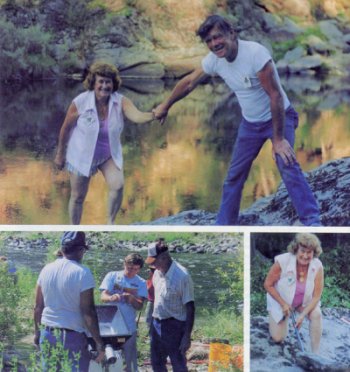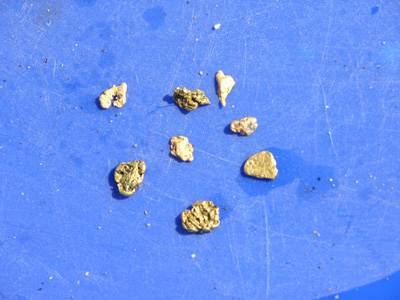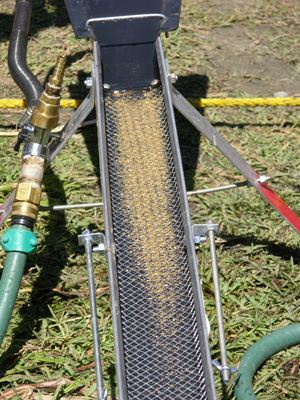BY HELEN PETERS
They are doing what each of them wants to do, they’re doing it together, and making a living at it!
 When she was a girl, Joy Cole’s dad took her along on his gold prospecting trips. She shared his excitement when they found the precious stuff, and from him learned to know and love the western lands that hid its glory from the casual seeker.
When she was a girl, Joy Cole’s dad took her along on his gold prospecting trips. She shared his excitement when they found the precious stuff, and from him learned to know and love the western lands that hid its glory from the casual seeker.
Ed Cole grew up in Massachusetts, far from the lore and lure of gold. Even after serving seventeen years in the Navy, teaching telemetry at the Federal Electric Corporation, and working for Northrup, what he knew or cared about gold wouldn’t have quivered a troy weight scale.
Today, Joy and Ed have combined their interests, expertise, and abilities into a profitable connection with gold and gold mining. They’re a modern gold mining success story.
“Ten years ago,” Ed says, “I didn’t even know what a gold pan was. A friend’s wife was working in a publishing house that published treasure magazines. I started reading them and became interested in the whole idea. The more I read, the more interested I got.”
 Joy, a petite, pretty gal with sparkling eyes, believes there’s more to it than that. She gets hunches. Maybe it has something to do with the close touch she’s had with the land, the love of it formed in those years she spent prowling and exploring with her father. She doesn’t apologize for respecting those feelings we can’t always explain.
Joy, a petite, pretty gal with sparkling eyes, believes there’s more to it than that. She gets hunches. Maybe it has something to do with the close touch she’s had with the land, the love of it formed in those years she spent prowling and exploring with her father. She doesn’t apologize for respecting those feelings we can’t always explain.
“A friend of mine went to a gold show,” she recalls. “He took a picture of a truck with his camera. It was a dazzling gold affair with the word ‘Goldfinders’ painted across it. Many months later, when we first met, Ed showed me this picture. It was his truck. Guess who was walking up the path in the picture? Me!”
“And,” she continues, “as we got to know each other, we discovered that the last four digits of his store’s telephone were the same as the last four digits of my home phone.”
Joy felt it was karma, or fate, that brought them together; and the way things were going for Ed at the time, he’d probably agree.
After being bitten by the treasure bug through his reading, Ed invested in some silver. When its value started rising, he got excited about precious metals. In addition, he’d just sold his house for a tidy profit, made a windfall playing the then-popular Pyramid Game; and having little love for his 9-5 existence, decided to become a gold miner. “I didn’t know gold from mica, but I quit my job, bought a dredge, a wet suit, the whole nine yards, and went to Placerville to make my living mining gold.”
 When he got there, he found it wasn’t quite that easy. “Here I am, and I don’t know how to do it, where to do it, or anyone who can show me. I ended up giving this guy $500 cash, with a promise to give him the first ounce of gold I got working his 20-acre claim.”
When he got there, he found it wasn’t quite that easy. “Here I am, and I don’t know how to do it, where to do it, or anyone who can show me. I ended up giving this guy $500 cash, with a promise to give him the first ounce of gold I got working his 20-acre claim.”
When he put his dredge in the river, there were four other hopefuls there before him—all working the same 20-acre claim. Ed’s weathered face breaks into a grin remembering his initiation into gold mining. “That guy never got any first ounce of my gold, because I never made an ounce that whole year!”
When winter came, Ed stopped mining. He still had plenty of money in the bank and nothing to do. He thought, “Here I am in Placerville, in the Mother Lode, and there’s not a mining supply store in town.” He decided to open one. In December, “Goldfinders” became a reality.
Then, when Spring came, Ed found himself living a familiar scenario. “I’m stuck in this damn store. I had quit my job before because I hated 9 to 5, and here I am—back to it again. I decide, the hell with this, sold everything, and went back to mining.” Ed holds up his toddy glass in salute, leaving it to you to decide which decision, quitting or starting, he’s drinking to.
Meanwhile, Joy’s love of rock-hounding and gold prospecting was keeping her out on the land she loved. After she was widowed, she became active in various gold prospecting and rockhounding clubs, was mining in the Coolgardie mining district in Barstow, and selling her own line of gold jewelry.
A fellow operating gravel pits along the Columbia River asked her to tell him how to recover the fine gold he was losing in his operation. Joy says, “A geologist had been out there and suggested he consult someone who could tell him how to save it. I turned out to be the ‘someone’.”
About this time, a friend approached her and asked her opinion of a separating device he’d invented. “The price of gold is going up,” she told him, “If it works, it’ll sell.” Joy was right. After some adjustments were made to the Gold Hawk Rocking Gold Pan, as it was called, they took it to the Coloma Gold Show where, she says, “It sold like hotcakes.”
Her reputation as a knowledgeable small-scale gold miner was growing, as well as her expertise in collectors’ items, gold bullion, silver and jewelry.
She and Ed first met at this show, and their common interest in gold mining and gold shows kept bringing them together.By now, not able to make a living at gold mining, Ed was back at a 9-5 job, locked into a lifestyle he hated. Weekends and vacation-time helped ease the tedium. Ed and Joy formed a partnership and mined together in the Coolgardie district. “It was kind of interesting,” she recalls, “what with the Mojave greens (rattlesnakes) and all.” In 1982 they added another facet to their gold mining partnership. They married.
Ed recalls how much he wanted to mine full time. “Gold mining was what I wanted to do, but I didn’t think I could make a living at it.” However, after months of discussion and indecision, they decided to go ahead. They said “good-bye,” to 9-5; “hello” to the goldfields.
During the years they’ve been mining full time, they’ve gained knowledge and experience in almost every aspect of small-scale gold mining.
Together, they’ve owned and worked heavy equipment, they’ve dry-washed, dredged and sniped. They have even drift-mined, something few small-scale gold miners have ever heard about, no less done. Today, most of their mining is the with a motorized sluice.
They are sought-after speakers for gold and treasure clubs. They give workshops and seminars for inexperienced miners. And, they willingly share their knowledge with anyone who is interested.
Joy has created beauty from the gold they work out of the earth. Her jewelry has found appreciative buyers, mainly because her work is different from most. “I don’t like doing the same as everyone else, “ she says. “I like to be an innovator, not an imitator. Once I see some of the things I’ve created being picked up by others, I create something new, different.”
Ed has invented a number of important gold and work-saving mining devices, some born of Joy’s suggestions.
Ed has very definite ideas about where small-scale gold mining is, and should be, going. He makes it clear he speaks for himself, not his wife, nor any gold mining organization. “There seems to be a feeling out there that the small-scale miner is getting something he’s really not entitled to. I don’t feel this way. I believe this is our land; it’s public land, we pay taxes on it, and small, recreational miners have as much right to mine it as big companies do.
“I think the only way the small-miner miner is going to keep his right to mine is to somehow get every treasure and gold prospecting club into one organization to fight for our right to use the public lands. It needs an organization with paid people—lawyers, administrators, public relations professionals—to do this. If we don’t pull it together now, we’re not going to have it later.” Ed raises his toddy, and we drink to that.
They are a complex couple, each complementing the other, each learning and doing with the other’s support. Ed is the consummate rebel. He left the Navy, on principle, three years before he would have been eligible for retirement and secure lifetime benefits. He broke from security and the established path to mine gold, a chancy occupation, at best.
Joy is a beautiful lady, like quicksilver, with a bubbling laugh and boundless enthusiasm for her lifestyle—a woman who counts a day lost if she hasn’t learned something new during the course of it.
Joy and Ed Cole represent what’s best in the small-scale mining field today. As self-employers, they bring dedication and persistence to what they’re doing, and wouldn’t think of doing anything else.
As miners, they bring independence, hard work, and respect for the environment in which they work. As entrepreneurs, they bring mining innovations and inventions to the market place. And as thinkers, they bring an awareness that, although government giveth, government can also taketh away.





